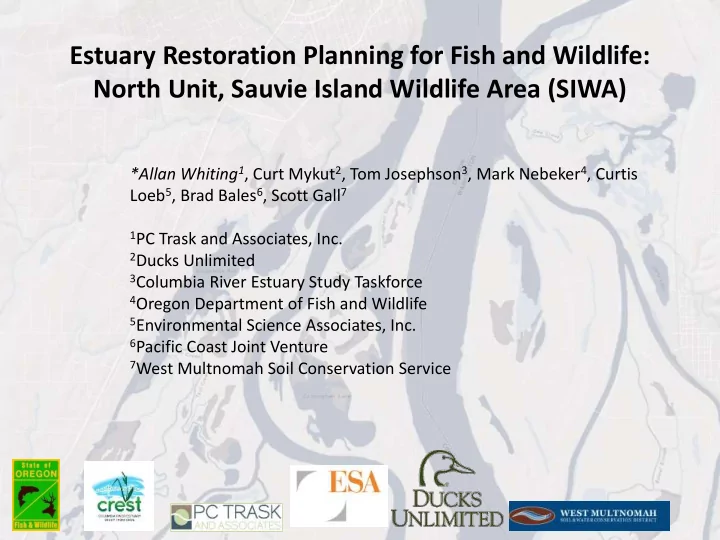

Estuary Restoration Planning for Fish and Wildlife: North Unit, Sauvie Island Wildlife Area (SIWA) *Allan Whiting 1 , Curt Mykut 2 , Tom Josephson 3 , Mark Nebeker 4 , Curtis Loeb 5 , Brad Bales 6 , Scott Gall 7 1 PC Trask and Associates, Inc. 2 Ducks Unlimited 3 Columbia River Estuary Study Taskforce 4 Oregon Department of Fish and Wildlife 5 Environmental Science Associates, Inc. 6 Pacific Coast Joint Venture 7 West Multnomah Soil Conservation Service
Presentation Outline • Background • Reach Context • Existing Site Conditions • Describe planning process used to engage SIWA staff and partners: – Goals and Objectives – Project Design Criteria – Restoration Concepts
Site Orientation
Reach F-Characteristics • Hydro modifications • Agricultural development • Navigation channel • Flood control infrastructure • Water control management • Urban inputs
North Unit Orientation • Owned and managed by Oregon Department of Fish & Wildlife for aquatic species and wildlife • 1600 acres of sloughs, wetlands, backwater swamps, and bottomland forests • Year 2000 water control structures installed in three major wetland areas for needs waterfowl and native wetland plant communities
Existing Conditions
Existing Conditions • Altered Hydrology from water control structures installed 2001- 2002 for waterfowl and vegetation objectives • Perched egress pipes (~10 feet NAVD88)
Existing Conditions • Homogeneous Plant Structure • Limited Sediment Transport
Existing Conditions Fish Population Structure
Presentation Outline • Background • Reach Context • Existing Site Conditions • Describe steps used to engage SIWA staff and partners: – Goals and Objectives – Project Design Criteria – Restoration Concepts
Goals and Objectives
Restoration Steps Developed to engage project sponsor and partners: • Develop Project Design Criteria using: – Current Understanding of Habitat Requirement for SIWA Priority Species of Interest – Water Level Collection and Analysis – Vegetation Survey – Topo Survey • Develop Restoration Concepts using : – Geomorphic Assessment – Hydrodynamic Modeling • Restoration Concepts for Design: – Barrier Removal – Elevation Manipulation – Riparian Plantings
Design Criteria: Habitat Requirements for SIWA Species • Water birds • Native Wetlands • Juvenile Salmon
Design Criteria: Water Level Observations
Design Criteria: Topographic Survey 16.0 14.0 12.0 Elevation, ft NAVD88 10.0 Millionaire 8.0 Deep Wigeon Ruby 6.0 Cunningham 4.0 2.0 0.0 0% 20% 40% 60% 80% 100% 120% Area Below Given Elevation, %
Design Criteria: Topographic Survey Survey
Water Level Analysis (Ruby Wetlands)
Design Criteria: Vegetation
Design Criteria (link to project objectives) Objective 1a – Habitat Opportunity Design Criteria 1: Establish full volitional access to interior wetlands of existing backwater areas by 100% channel width ingress/egress (free and open connection) Design Criteria 2: Expand access to interior channel edge network by 25% Design Criteria 3: Expand surface water area connection and duration to interior wetlands and channels by 20 acres (seasonality) Design Criteria 4: No adverse impacts on in channel habitat conditions: velocity < 2 ft/s and depths > 0.5 feet (90% of the time) Objective 1b – Habitat Quality Design Criteria 5: At strategic locations, lower/maintain ground elevation to 7.5-8.5 feet NAVD88 to induce native plant propagation Design Criteria 6: Maintain 2 feet of water level elevation over wetland surface during February-March to restrict germination capacity of invasive species Design Criteria 7: Increase area of native plant community by 25% Objective 1c – Ecological Function Design Criteria 8: Maintain floodplain activation zone (shrub-scrub, woody vegetation layer) at >9.0 feet NAVD88 to increase estuarine food web capacity during juvenile rearing period (November-June)
Restoration Steps Developed to engage project sponsor and partners: • Develop Project Design Criteria using: – Current Understanding of Habitat Requirement for SIWA Priority Species of Interest – Water Level Collection and Analysis – Vegetation Survey • Develop Restoration Concepts using : – Geomorphic Assessment – Hydrodynamic Modeling • Restoration Concepts for Design: – Barrier Removal – Elevation Manipulation – Riparian Plantings
Geomorphic Assessment Bar and Scroll Crevasse Splay
Geomorphic Assessment • Crevasse Splays • Backswamps • Natural Levees • Bar and Scroll • Slough Channels
Hydrodynamic Modeling – Zone 3 (September) 10:00 Hrs 12:00 Hrs 14:00 Hrs 16:00 Hrs 18:00 Hrs 20:00 Hrs
Planning process used to engage project sponsor and partners: • Develop Project Design Criteria using: – Current Understanding of Habitat Requirement for SIWA Priority Species of Interest – Water Level Collection and Analysis – Vegetation Survey • Develop Restoration Concepts using : – Geomorphic Assessment – Hydrodynamic Modeling • Restoration Concepts: – Barrier Removal – Elevation Manipulation – Riparian Plantings
Design Element: Elevation Manipulation
Modeling Results from preferred alternative (Zone 2) No change in water levels from WCS removal + 81% increase in depth from large scrapedown: -66% increase in 1-2 feet depth -83% increase in 2 feet or greater Increase in 5 acre feet more volume from restoration (tidal);30-40% from existing condition
Construct: Barrier Removal
Construct: Elevation Manipulation
Construct: Riparian Plantings
Managing Uncertainty: Adaptive Management Plan
Future North Unit Stewards
Summary • Combination of planning process and baseline monitoring leads to collective knowledge of unique Reach F system • Goals, objectives, design criteria development key to meeting needs of multiple, estuary-dependent species • Geomorphology key for development of cost-effective restoration measures • Uncertainty mitigated in part by evolving adaptive management plan as system responds to restoration • Template for future work in seasonally inundated reaches of Columbia River Estuary
Gratitude! • Bonneville Power Administration • Institute for Applied Ecology • Sauvie Island Habitat Partnership • Sauvie Island Academy • Statewide Surveying
Recommend
More recommend